| Designation: | Mark Eleven |
 |
|---|---|---|
| Manufacturer: | Vickers Defence Systems Ltd. | |
| Product type: | Armoured Vehicles | |
| Name: | Reconnaissance Vehicle |
The Mark Eleven is a unique family of vehicles which provides a complete range of capabilities to the user. Designed for the changing defence requirements of the 1990's and beyond, the Mark Eleven family includes:
The Long Range Patrol Vehicle combining the firepower and mobility of a tank, the troop carrying capacity of an APC and the range of a reconnaissance vehicle.
A range of Fire Support Vehicles with equipment from ATGW, through turreted mortars, to anti aircraft guns.
An APC which can carry two sections of infantry.
High roof Command Post and Ambulance variants which combine a useful six square metres of floor area whilst allowing personnel room to stand up unhindered.
Logistic vehicles, based on a common flatbed chassis, include the base load-carrier, Recovery Vehicle, mechanical handling, Water Cannon and container body options.
All variants are based on a common chassis which offers excellent strategic and tactical mobility - 1000km road range.
Use of Commercial Automotives, providing:
- Proven reliability
- Low Initial Cost and through life cost
- Ready access to spares, world wide
- Amphibious option
The variants all share common automotive components, permanent six wheel drive and full independent suspension. The front wheels are steered and the rear pairs close coupled. All automotives including the engine, gearbox, transfer drive, disc brakes and drive shafts are protected within the armoured hull. This gives the hull a smooth underside which facilitates cross country driving and swimming. The powerpack is easily removable and consists of the turbo-charged diesel engine, transmission and radiators.
The Mark Eleven family of vehicles has excellent all round armour protection for its class and weight. This protection can be enhanced to meet customers' specific requirements.
The driver can be seated on either the right or left of the vehicle and has power steering and user friendly controls and instruments. Alongside the driver is a seat for the vehicle commander. There is an escape hatch in the roof of the drivers compartment.
Crew access to the vehicle is through a large door on the left hand side of the hull whilst the infantry have double hinged doors at the rear allowing rapid exit and entry. There are escape hatches in the roof. Ample space is provided for the stowage of individual weapons and personal kit either behind, or under the seats. A small door on the right hand side gives access to a stowage area.
Mark Eleven is powered by a turbocharged diesel engine operating through a fully automatic six speed gearbox. Drive is transmitted to the six wheels by lockable differential units and hub reduction gears. Suspension is fully independent. Different engine power outputs are used for the variants to ensure a power to weight ratio of some 20hp/tonne, giving Mark Eleven a road speed in excess of 100 km/hr. A digital electrical distribution system maximizes reliability while minimizing the quantity of cables routed through the hull.
The engine is a turbocharged diesel providing either 350 or 500 bhp to suit the operational requirements. The engine is coupled through a torque converter to a six speed fully automatic transmission which has electronic shift in order to prevent accidental damage to the engine or gearbox. The rear of the transmission carries an integral transfer drive with front/rear lockable differential. The engine and transmission are built into a Powerpack which carries the fans, radiators, air cleaner and other ancillaries. The engine can be tuned to run on commercial diesel, military diesel or JP8 aviation fuel.
The output from the transfer box is taken forward to the front axle unit by a propeller shaft and to the rear by a short coupling into the mid axle. The differential on each axle unit is lockable. The axle half shafts drive the wheels through epicyclic hub reduction units. A clutch controlled power take off on the rear axle drives the Hydrojet units for swimming or provides drive for a powered trailer. The axle units are positioned under the hull and are mounted on anti vibration mounts to reduce noise transmission. The location of the axles contributes to the integrity of the hull structure and enables the axles to be replaced very quickly and easily.
The hydraulically operated disc brakes are mounted inboard on each side of the axle units. Since the brakes operate forward of the hub reduction units the braking effort is reduced by the ratio of the reduction gears. The position of the brakes means that they do not contribute to the vehicle unsprung weight and are protected from damage. In addition they are accessible for pad changing without removing the wheels. The braking system is air over hydraulic with air pressure supplied by an engine driven compressor. The system can be fitted with an Anti-lock Braking System (ABS) to prevent wheel lock when brakes are applied.
All six wheels have identical suspension units with long bottom wishbone and a short upper control arm. Twin variable rate coil springs are fitted to each suspension unit with a suspension damper unit fitted inside one of them. The wishbone and control arm are assembled onto a mounting plate which is bolted to the hull. The suspension units are therefore easily replaced in the event of battle damage. A rubber spring unit on the hull gives a rising rate bump stop characteristic, while rebound is controlled by an adjustable wire rope check strap. The long travel suspension gives excellent cross country performance and provides the greatest level of crew comfort.
Each vehicle in the Mark Eleven family has different electrical requirements. In order to simplify the electrics and to improve fault finding a data bus system is used. The system consists of a two wire data bus and a two wire power bus which connect encoders and decoders together. This highly advanced electrical system not only gives high levels of reliability but also produced a logged fault message for any system failure caused by battle damage or component failure.
Mark Eleven's watertight hull enable it to swim without preparation at a speed of 8km per hour. Hydrojets, which provide both propulsion and steering, are driven mechanically from a power take off from the rear axle unit.While swimming the transmission is locked in second gear so that the wheels continue to rotate in the water enabling Mark Eleven to climb out easily on the far bank.
Power assisted rack and pinion steering is standard on the Mark Eleven enabling both women and men to drive with ease. A simple indicator on the dashboard shows the position of the wheels relative to the vehicle; an essential aid when manoeuvring in soft going.
The standard tyres on the Mk Eleven are 14.00 R 20 XML tubeless radial ply with improved sidewalls and a runflat insert. The runflat inserts allows the vehicle to be driven at 50 km/hr for at least 10 km after a puncture. Runflat inserts reduce the volume of air in the tyre which speeds up reinflation by the Central Tyre Inflation System.
As an option, where particularly low ground pressure is required, the standard tyres can be replaced with 475/80 R 20 XML tyres, again with runflat inserts. These tyres are 100 mm wider than the standard.
The Mark Eleven Long Range Border Patrol Vehicle is designed to combine the firepower of a tank together with the carrying capacity of an APC. It will transport the two man turret crew, driver and eight infantrymen for a distance of 1000 km at speeds up to 105 km/hr. There is ample stowage space for combat supplies for sustained operations. An air conditioning system and collective NBC protection can be fitted.
The fabricated aluminium armour turret is equipped with a low recoil 105 mm L7 gun and fires standard NATO ammunition. Eighteen ready to use main armament rounds
are stowed in the turret with a further eighteen in the hull. The commander/gunner sits on the right of the turret while the loader/radio operator sits on the left. The commander has excellent all round vision with a ring of periscopes in his hatch as well as a stabilised primary gun sight and co-axial auxiliary sight. The loader has a hatch with a pintle mount for a 12.7 mm MG and a rotating periscope. There is also a coaxial 7.62 mm MG. The turret has all round power traverse and can power elevate to 20° and depress to -7°, except where limited by the hull. A gyroscopic system provides stabilisation for both sight and gun. Emergency manual traverse and elevation are provided.
The commander has a stabilised primary sight which controls the gun and is very easy to use. The aiming mark is a simple central dot with a small circle round it. The commander uses his duplex controller to lay the dot over the target and track it. The built in Nd YAG laser provides target range to the fire control computer which then aims the gun and gives a signal that it is ready to fire. The gun fires when coincidence is achieved between the gun and sight. The primary sight also has a unity vision window for direct forward vision. As a back up the commander has an auxiliary sight mounted co-axially with the gun. The auxiliary sight also provides a muzzle reference system which enables the primary sight to be maintained in perfect alignment with the gun barrel, via the fire control computer.
The 105 mm L7 Gun is able to fire all NATO standard ammunition which has a wide variety of natures to suit all targets and purposes. Typical types are: Armour Piercing Fin Stabilised Discarding Sabot (APFSDS), Armour Piercing Discarding Sabot (APDS), High Explosive Anti-Tank (HEAT), High Explosive Squash Head (HESH), smoke and illuminating. In addition a range of low cost training rounds is available.
Typically the 105 mm Armour Piercing Fin Stabilised Discarding Sabot (APFSDS) round will defeat the NATO Heavy Triple Target at a range of 4,500 m.
The muzzle brake fitted to Mark Eleven uses the energy of the propellant gases to reduce the recoil force by up to 40% aiding vehicle stability and crew comfort when the gun is fired.
A muzzle reference system (MRS) is fitted to ensure accurate alignment of the sights to the end of the barrel under all operating conditions. It operates by simple adjustments being fed to the fire control computer via the auxiliary sight.
The Mark Eleven has digital, all electric, turret and gun drives using brushless AC servo technology. The system provides precise alignment at low speeds for target tracking and high slew speeds for acquiring targets rapidly. The gun is stabilised and slaved to follow the primary sight. The gun control equipment interfaces with the fire control computer to provide fast, accurate engagements.
The Mark Eleven family includes a wide range of fire support variants designed to fulfil any mission. Given the load carrying capacity of the vehicle chassis and the space available it would be possible to fit almost any turret, as specified by the customer. The existing options range from an APC, with a 7.62 MG cupola and carrying up to nineteen infantrymen, to a series of turret systems with 25 mm chain gun, up to a 120 mm mortar. These options allow the vehicle to be used in a number of roles including anti-aircraft, with a missile system; anti-helicopter, with a 40 mm cannon, and long range bombardment with the 120 mm mortar. The vehicle chassis in this configuration can carry turrets up to 5 tonnes in weight and so will be able to accommodate future weapon systems that may be developed. Lighter variants can be supplied with a 350 bhp power pack to give improved fuel economy.
The APC offers ample space for up to nineteen men and their equipment. The infantry sit back to back down the middle of the crew compartment with firing ports and vision blocks in the vehicle side opposite them. They can obtain greater fields of fire by using the double hatches mounted in the roof. A cupola, with all round vision blocks and a 7.62 mm or 12.7 mm MG, is mounted on the roof.
Radios are mounted close to the commander. An intercom system allows the commander to address the crew over a two way loudspeaker system. A manpack radio set is stowed just inside the rear doors where it is kept charged and ready to be dismounted with the infantry. A talkback system is mounted on the front of the vehicle to allow the driver to communicate with dismount infantry.
One of the features of the Mark Eleven is its long range. Crew comfort is essential if the vehicle is to be occupied for long periods. Full air conditioning and collective NBC protection are available. Long travel suspension ensures a good ride while the comfortable seats are all equipped with seat belts. The width of the vehicle permits ample leg room and space for stowage of personal kit and weapons. Two removable drinking water tanks are fitted together with cooking facilities.
Normal access to the vehicle is by the two rear doors for the infantry section and a door on the left hand side for the vehicle crew. A small door provides access to batteries and stowed equipment on the right hand side. There are hatches in the roof above the commander and driver and a cupola with a hatch to their rear. In the roof above the passenger compartment there are 8 hatches, each large enough for two men, four on each side of the vehicle and hinged near the centre line, allowing the infantry to stand up to provide unrestricted fire.
The modular design of the Mark Eleven and the large load area allow it to be configured for a variety of roles such as command post and field ambulance. In the command post role the spacious passenger compartment enables modern battlefield Command Control Communications and Intelligence systems to be installed together with map boards, seats and lighting. In this configuration there is no need to fit a tented penthouse on the rear of the vehicle since the standard vehicle has sufficient space for a regimental CP.
The Mark Eleven provides ample space for a sophisticated command post layout. Two 1.5m mapboards can be fitted on the side walls together with full length desk space. Four watchkeepers can sit at the desk with the watch controller having an overall view. All modern computer and communications equipment can be fitted. The Mark Eleven ensures that the passengers and their equipment travel in a comfortable, low noise, vibration free environment.
Command posts can be designed to accommodate customers's individual needs.
The ambulance variant can be supplied in either standard height or in a high roofline version. The high roof variant has sufficient height to allow the medical orderly to stand up in order to carry out first aid or resuscitation. The excellent ride provided by the long travel independent suspension ensures a comfortable ride for casualties.
With space for 4 stretchers and 4 sitting patients the Mark Eleven makes an excellent armoured ambulance. There is sufficient headroom for the medical orderly to stand up so that stretcher cases can be tended to. There is also ample space and racking for infusion bottles, oxygen, refrigerated supplies and general medical equipment. Air conditioning and heating ensures that the environment is maintained at a comfortable temperature. The ambulance can be fitted with a 20 foot powered trailer carrying a modular hospital unit with mechanical handling equipment to load and unload the unit.
The chassis of the Mark Eleven provides the basis for an ideal High Mobility Load Carrier (HMLC). The load space on the rear of the vehicle is able to accept a wide variety of equipment to fit the vehicle for the DROPS type system, as a recovery vehicle, water cannon, mobile workshop and many other specialist functions. The vehicle also has a power take off at the rear to enable the towing of a powered trailer to increase considerably the load carrying handling capacity.
The Mark Eleven makes an ideal High Mobility Load Carrier because of its large unobstructed load area and the capability to carry up to seven tonnes. These factors, coupled with its 1000 km range, top speed of over 100 km/hr and excellent cross country mobility, make the ideal general purpose armoured cargo carrier. Its capability can be further enhanced by use of the associated powered trailer which will carry a standard 20 ft container with little or no degradation in cross country performance.
When fitted with the recovery module the Mark Eleven is transformed into a highly capable repair and recovery vehicle able to provide all the necessary field and workshop support for a medium vehicle fleet. The 25 tonne winch can extract and recover all the Mark Eleven variants with a straight pull. By double reeving the rope vehicles up to 40 tonnes can be recovered. The crane has a maximum capacity of 15 tonnes and can lift the front of the vehicle for a suspended tow. The crane is also positioned so as to remove the power pack and the 105 mm turret.
The flat rear deck allows a water cannon module with an 8000 litre tank to be readily fitted to the Mark Eleven logistic vehicle. Baffles within the water tank prevent surging. Facilities to inject foam for fire fighting can be included. The cannon is powered by its own diesel driven pump and has a range of 25 to 30 m as a continuous jet, with a duration of 25 to 30 minutes. Remote control facilities allow the cannon, mounted on the roof, to be operated from within the protection of the armoured cab over a 120° frontal arc, with elevation of 40° and 15° depression.
The capability to mount a standard container gives the Mark Eleven logistic vehicle tremendous flexibility. A particular useful application is the fitment of a workshop module. The workshop contains all the tools and test equipment necessary to enable the base vehicle and turret system to be serviced or repaired. Test equipment used for diagnostic analysis, as well as facilities for working on sub-assemblies within the workshop, are provided. Operating in conjunction with the recovery vehicle the two facilities together provide a very powerful field engineering capability.
The DROPS system is becoming the standard for rapid deployment and re supply of logistic material. Mark Eleven's flat rear deck and the space underneath it make the vehicle ideal to configure as a DROPS platform. The DROPS system allows the vehicle, without outside help, to lift a loaded pallet off the ground and onto the vehicle where it is securely held. The pallet can then be off loaded in a similar manner.
|
||||||||||||||||||||||||||
|
||||||||||||||||||||||||
 |
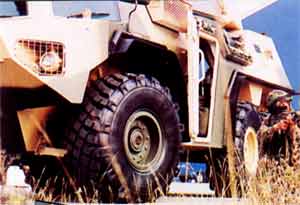 |
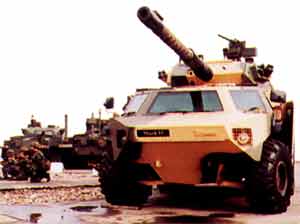 |
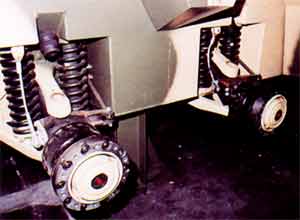 |
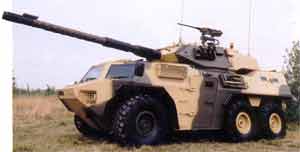 |
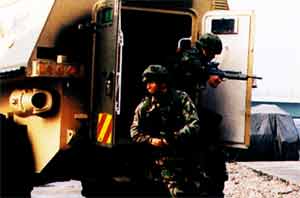 |
 |
 |
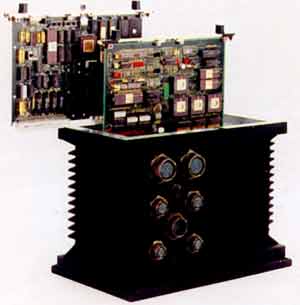 |
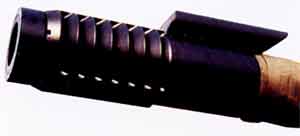 |
 |
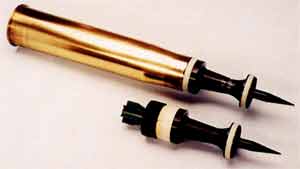 |
 |
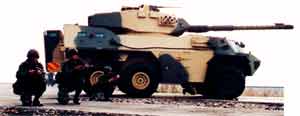 |
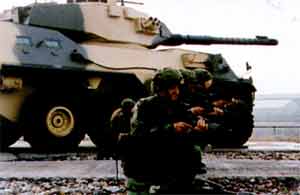 |
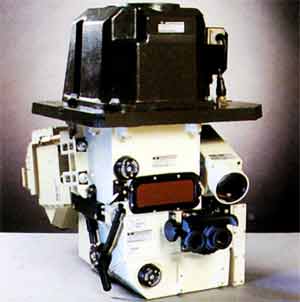 |
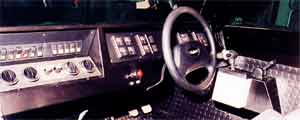 |
 |
 |
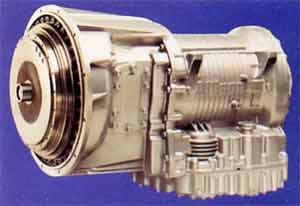 |
 |
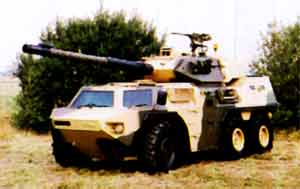 |
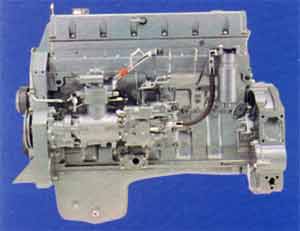 |